On the High-Resolution Discretization of the Maxwell Equations in a Composite Tape and the Heating Effects Induced by the Dielectric Losses
Abstract
1. Introduction
2. Modeling of the Composite-Materials Heating Process
2.1. Electromagnetic Formulation
2.2. Thermal Modeling
3. PGD Applied to Space Decomposition
4. High-Resolution Electromagnetic Simulation and Process Parameters
4.1. Simulation of a Composite Part with Extruded In-Plane Section
- The electric field penetration inside the part is deeper for lower frequencies, and the electric field exhibits, therefore, a higher intensity for lower frequencies;
- The electric field penetration inside the part is higher when the wave polarization is parallel to the fiber orientation.
4.2. Simulation of a Real 3D-Scanned Composite Part
5. Thermal Simulation
6. Conclusions
Author Contributions
Funding
Data Availability Statement
Acknowledgments
Conflicts of Interest
References
- Nedelec, J.C. Mixed finite elements in R3. Numer. Math. 1980, 35, 315–341. [Google Scholar] [CrossRef]
- Chew, W.C.; Nasir, M.A. A Variational analysis of anisotropic, inhomogeneous dielectric waveguides. IEEE Trans. Microw. Theory Technol. 1989, 37, 661–668. [Google Scholar] [CrossRef]
- Bensaid, S.; Trichet, D.; Fouladgar, J. 3D simulation of induction heating of anisotropic composite materials. IEEE Trans. Magn. 2005, 41, 1568–1571. [Google Scholar] [CrossRef]
- Bensaid, S.; Trichet, D.; Fouladgar, J. Electromagnetic and thermal behaviours of multi-layer anisotropic composite materials. IEEE Trans. Magn. 2006, 42, 995–998. [Google Scholar] [CrossRef]
- Boyse, W.E.; Lynch, D.R.; Paulsen, K.D.; Minerbo, G.N. Nodal-based finite-element modeling of Maxwell equations. IEEE Trans. Antennas Propag. 1992, 40, 642–651. [Google Scholar] [CrossRef]
- Bui, H.K.; Wasselynck, G.; Trichet, D.; Berthiau, G. Degenerated hexahedral whitney elements for electromagnetic fields computation in multi-layer anisotropic thin regions. IEEE Trans. Magn. 2016, 52, 7208104. [Google Scholar] [CrossRef]
- Mur, G. Edge elements, their advantages and their disadvantages. IEEE Trans. Magn. 1994, 30, 3552–3557. [Google Scholar] [CrossRef][Green Version]
- Mur, G. The fallacy of edge elements. IEEE Trans. Magn. 1998, 34, 3244–3247. [Google Scholar] [CrossRef]
- Costabel, M.; Dauge, M. Weighted regularization of Maxwell equations in polyhedral domains. Numer. Math. 2002, 93, 239–277. [Google Scholar] [CrossRef]
- Pineda, M.; Chinesta, F.; Roger, J.; Riera, M.; Perez, J.; Daim, F. Simulation of skin effect via separated representations. Int. J. Comput. Math. Electr. Electron. Eng. 2010, 29, 919–929. [Google Scholar] [CrossRef][Green Version]
- Gentili, G.G.; Accatino, L. A 2.5D FEM analysis of E-plane structures. In Proceedings of the 2014 International Conference on Numerical Electromagnetic Modeling and Optimization for RF, Microwave, and Terahertz Applications (NEMO), Pavia, Italy, 14–16 May 2014. [Google Scholar] [CrossRef]
- Barasinski, A.; Ghnatios, C.; Abenius, E.; Bechtel, S.; Chinesta, F. Electromagnetic field propagation in a composite laminate and induced thermal field: Application to microwave composites processing. Int. J. Mater. Form. 2021, 14, 97–103. [Google Scholar] [CrossRef]
- Otin, R. Regularized Maxwell equations and nodal finite elements for electromagnetic field computations. J. Electromagn. 2010, 30, 190–204. [Google Scholar] [CrossRef]
- Otin, R. ERMES: A nodal-based finite element code for electromagnetic simulations in frequency domain. Comput. Phys. Commun. 2013, 184, 2588–2595. [Google Scholar] [CrossRef]
- Ghnatios, C. Simulation Avancée des Problemes Thermiques Rencontrés lors de la mise en forme des Composites. Ph.D. Thesis, Ecole Centrale Nantes, Nantes, France, October 2012. [Google Scholar]
- Ammar, A.; Mokdad, B.; Chinesta, F.; Keunings, R. A new family of solvers for some classes of multidimensional partial differential equations encountered in kinetic theory modeling of complex fluids. J. Non-Newton. Fluid Mech. 2006, 139, 153–176. [Google Scholar] [CrossRef]
- Bognet, B.; Leygue, A.; Chinesta, F.; Poitou, A.; Bordeu, F. Advanced simulation of models defined in plate geometries: 3D solutions with 2D computational complexity. Comput. Methods Appl. Mech. Eng. 2012, 201, 1–12. [Google Scholar] [CrossRef]
- Bognet, B.; Leygue, A.; Chinesta, F. Separated representations of 3D elastic solutions in shell geometries. Adv. Model. Simul. Eng. Sci. 2014, 1, 1–34. [Google Scholar] [CrossRef]
- Lallechere, S. Efficient 3-D electromagnetic modeling procedure of composite materials in microwave frequency range: Application to EMC characterization of complex media by statistical means. Adv. Electromagn. 2017, 6, 46–52. [Google Scholar] [CrossRef]
- O’Connor, K.A.; Curry, R.D. Three-dimensional electromagnetic modeling of composite dielectric materials. In Proceedings of the 2011 IEEE Pulsed Power Conference, Chicago, IL, USA, 19–23 June 2011. [Google Scholar] [CrossRef]
- Nuhiji, B.; Bower, M.P.; Swait, T.; Phadnis, V.; Day, R.J.; Scaife, R.J. Simulation of carbon fibre composites in an industrial microwave. Mater. Today Proc. 2021, 34, 82–92. [Google Scholar] [CrossRef]
- Achkar, G.A.; Pichon, L.; Daniel, L.; Benjelloun, N. Effective Electromagnetic Properties of Woven Fiber Composites for Shielding Applications. IEEE Trans. Electromagn. Compat. 2020, 62, 1082–1089. [Google Scholar] [CrossRef]
- Wang, C.; Li, J.; Guo, S. High-performance electromagnetic wave absorption by designing the multilayer graphene/thermoplastic polyurethane porous composites with gradient foam ratio structure. Compos. Part A 2019, 125, 105522. [Google Scholar] [CrossRef]
- Marra, F.; Lecini, J.; Tamburrano, A.; Pisu, L.; Sarto, M.S. Electromagnetic wave absorption and structural properties of wide-band absorber made of graphene-printed glass-fibre composite. Nat. Sci. Rep. 2018, 8, 12029. [Google Scholar] [CrossRef] [PubMed]
- Tzeng, J.; Hsieh, K.-T. Electromagnetic analysis of composite structures subjected to transient magnetic fields. J. Compos. Mater. 2020, 54, 745–752. [Google Scholar] [CrossRef]
- Rezgui, S.; Mohellebi, H.; Féliachi, M. Electromagnetic modeling of carbon-fiber reinforced composite materials using the wave digital concept. Multidimens. Syst. Signal Process. 2018, 29, 405–430. [Google Scholar] [CrossRef]
- Yafei, S.; Peiwei, G.; Hailong, P.; Hongwei, L.; Xiaolin, L.; Kai, S. Electromagnetic wave absorbing and mechanical properties of cement-based composite panel with different nanomaterials. Adv. Compos. Lett. 2017, 26, 6–11. [Google Scholar] [CrossRef]
- Chinesta, F.; Ammar, A.; Cueto, E. Recent advances and new challenges in the use of the Proper Generalized Decomposition for solving multidimensional models. Arch. Comput. Methods Eng. 2010, 17, 327–350. [Google Scholar] [CrossRef]
- Chinesta, F.; Keunings, R.; Leygue, A. The Proper Generalized Decomposition for Advanced Numerical Simulations. A Primer; Springerbriefs; Springer: Cham, Switzerland, 2014. [Google Scholar]
- Bur, N.; Joyot, P.; Ghnatios, C.; Villon, P.; Cueto, E.; Chinesta, F. Advanced computational vademecums for Automated Fibre Placement processes. Adv. Model. Simul. Eng. Sci. 2016, 3, 1–22. [Google Scholar] [CrossRef]
- Chinesta, F.; Ammar, A.; Leygue, A.; Keunings, R. An overview of the Proper Generalized Decomposition with applications in computational rheology. J. Non Newton. Fluid Mech. 2011, 166, 578–592. [Google Scholar] [CrossRef]
- Chinesta, F.; Ladeveze, P.; Cueto, E. A short review in model order reduction based on Proper Generalized Decomposition. Arch. Comput. Methods Eng. 2011, 18, 395–404. [Google Scholar] [CrossRef]
- Chinesta, F.; Leygue, A.; Bordeu, F.; Aguado, J.V.; Cueto, E.; Gonzalez, D.; Alfaro, I.; Ammar, A.; Huerta, A. PGD-based computational vademecum for efficient design, optimization and control. Arch. Comput. Methods Eng. 2013, 20, 31. [Google Scholar] [CrossRef]
- Chinesta, F.; Leygue, A.; Bognet, B.; Ghnatios, C.; Poulhaon, F.; Bordeu, F.; Barasinski, A.; Poitou, A.; Chatel, S.; Maison-Le-Poec, S. First steps towards an advanced simulation of composites manufacturing by Automated Tape Placement. Int. J. Mater. Form. 2014, 7, 81–92. [Google Scholar] [CrossRef]
- Tertrais, H.; Ibanez, R.; Barasinski, A.; Ghnatios, C.; Chinesta, F. On the Proper Generalized Decomposition applied to microwave processes involving multilayered components. Math. Comput. Simul. 2019, 156, 347–363. [Google Scholar] [CrossRef]
- Ghnatios, C.; Bognet, B.; Barasinski, A.; Chinesta, F. Proper Generalized Decomposition Based Model Order Reduction Applied to Problems Defined in Degenerated Domains. In Advances in Computers and Information in Engineering Research, 2nd ed.; ASME-ACIER Book Series; American Society of Mechanical Engineers: New York, NY, USA, 2021; pp. 1–30. [Google Scholar]
- Ghnatios, C.; Chinesta, F.; Barasinski, A. Electrical Fields Simulation in Heterogenous Domains Using the Proper Generalized Decomposition. In Proceedings of the ECCOMAS Congress, Crete Island, Greece, 5–10 June 2016. [Google Scholar]
- Jin, J. The Finite Element Method in Electromagnetics, 2nd ed.; John Wiley & Sons: Hoboken, NJ, USA, 2002. [Google Scholar]
- Hazard, C.; Lenoir, M. On the solution of the time-harmonic scattering problems for Maxwell equations. SIAM J. Math. Anal. 1996, 27, 1597–1630. [Google Scholar] [CrossRef]
- Perez, M.; Barasinski, A.; Courtemanche, B.; Ghnatios, C.; Chinesta, F. Sensitivity thermal analysis in the laser-assisted tape placement process. Aims Mater. Sci. 2018, 5, 1053–1072. [Google Scholar] [CrossRef]
- Ghnatios, C.; Zehil, G.-P.; Habchi, C. Modeling of the vane test using a power-law fluid and model order reduction techniques: Application to the identification of cement paste properties. Comptes Rendus Mec. 2021, 349, 501–517. [Google Scholar] [CrossRef]
- Ghnatios, C.; Abisset, E.; Ammar, A.; Cueto, E.; Duval, J.-L.; Chinesta, F. Advanced separated spatial representations for hardly separable domains. Comput. Methods Appl. Mech. Eng. 2019, 354, 802–819. [Google Scholar] [CrossRef]
- Hug, G. Analyse du Comportement de Stratifiés Carbone/Epoxy sous Sollicitation Rapide. Elaboration par Electrothermie Diélectrique d’un même Matrériau pour Comparaison. Ph.D. Thesis, Ecole Nationale supérieur des Arts et Métiers, Paris, France, July 2005. [Google Scholar]
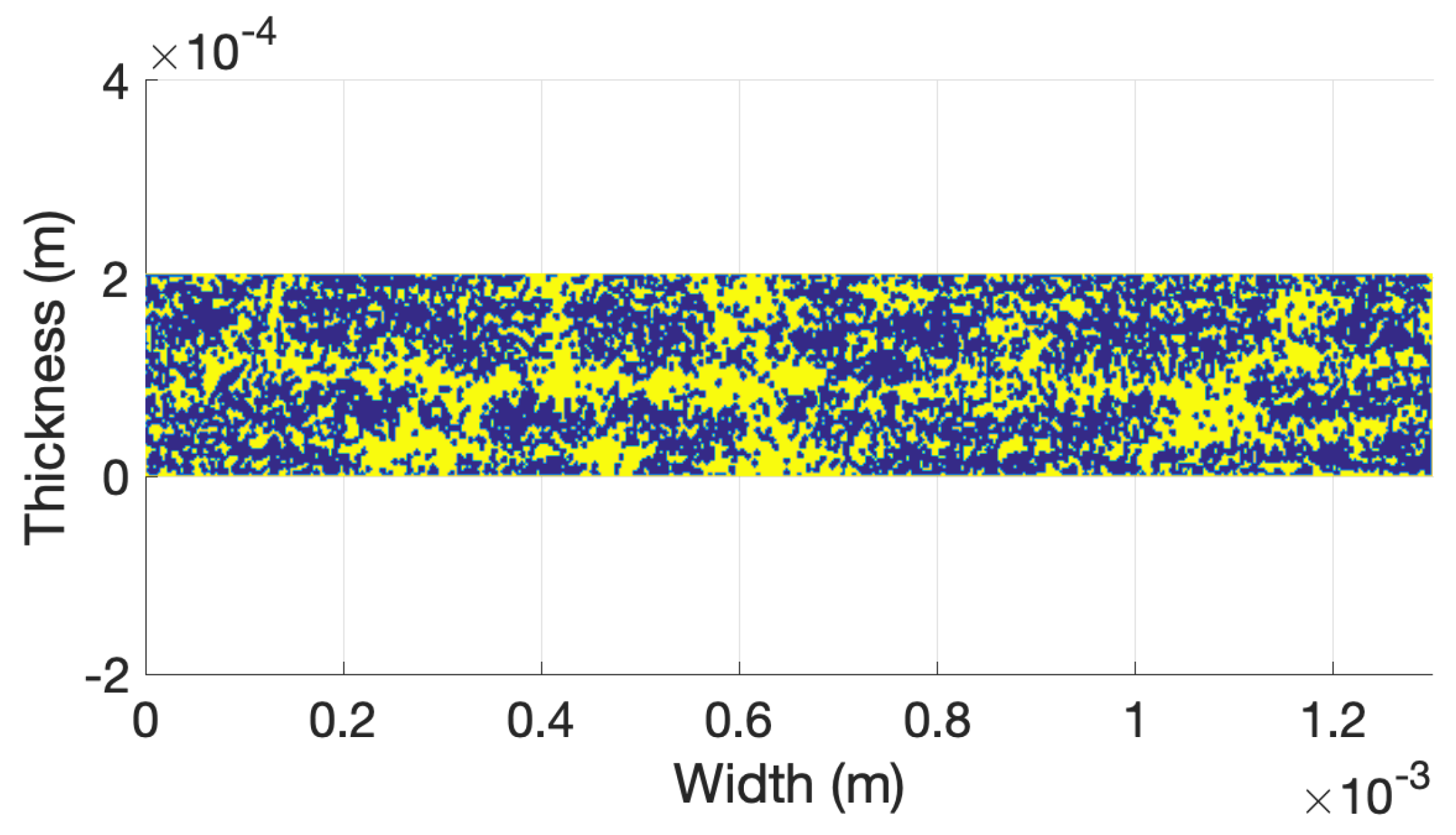
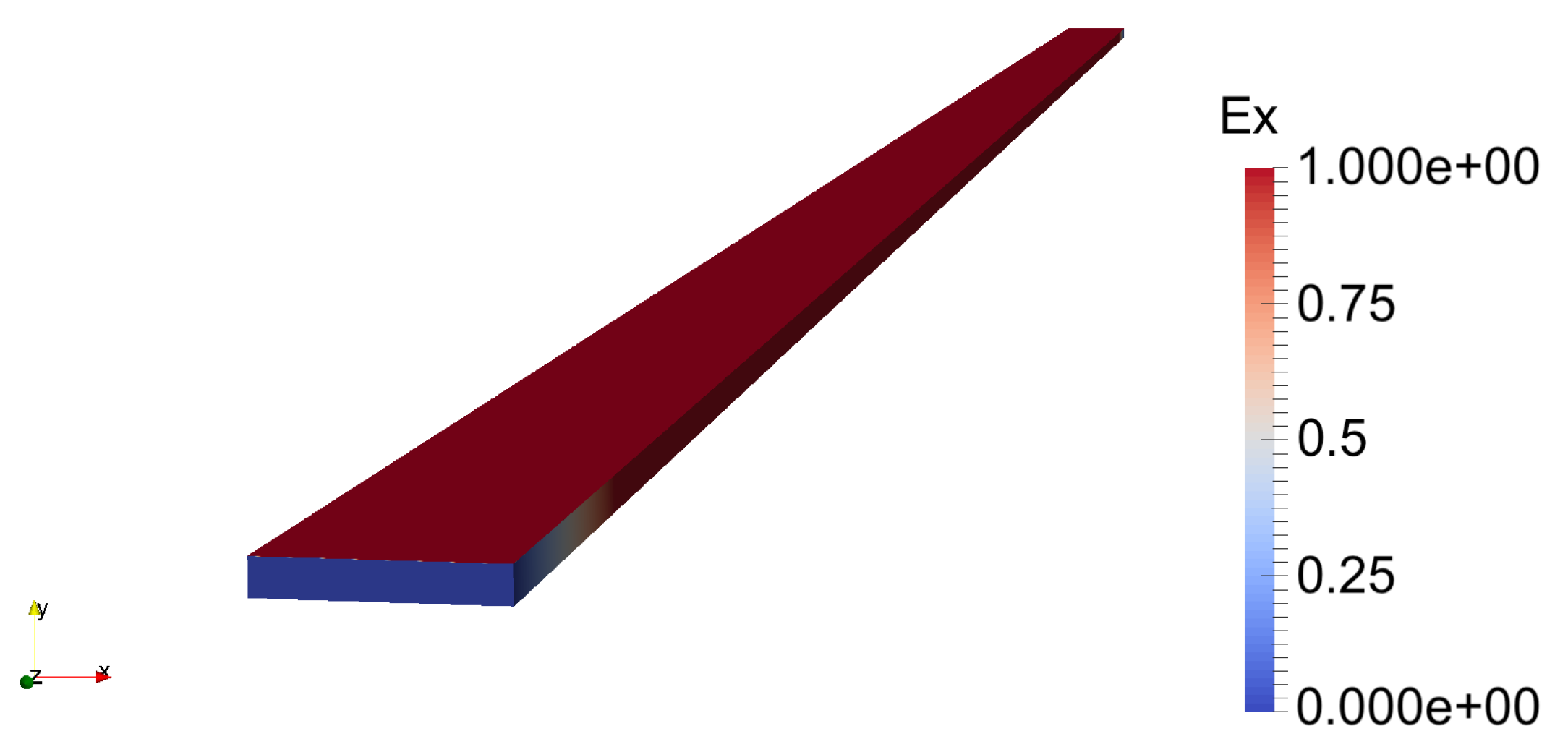
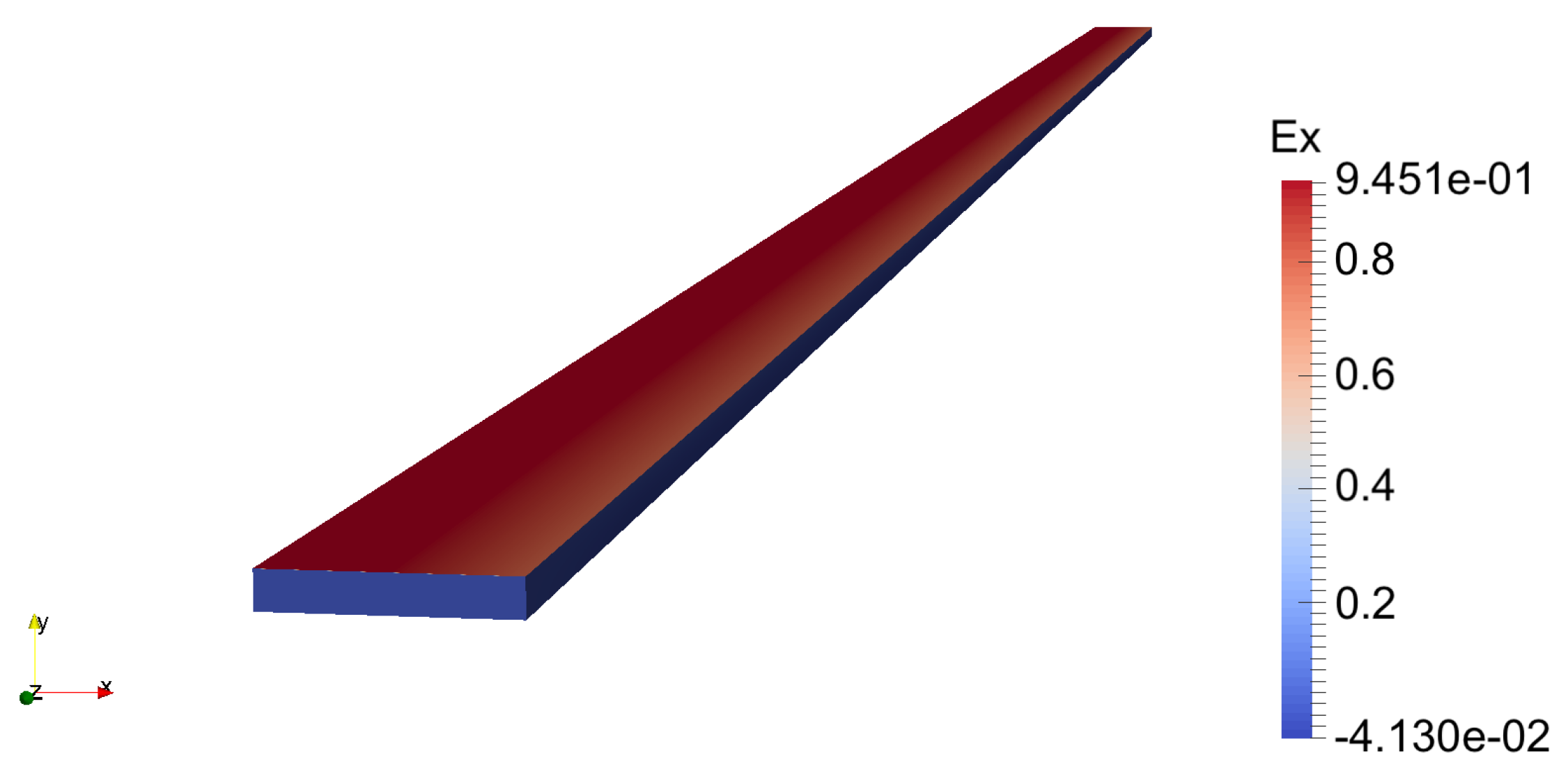
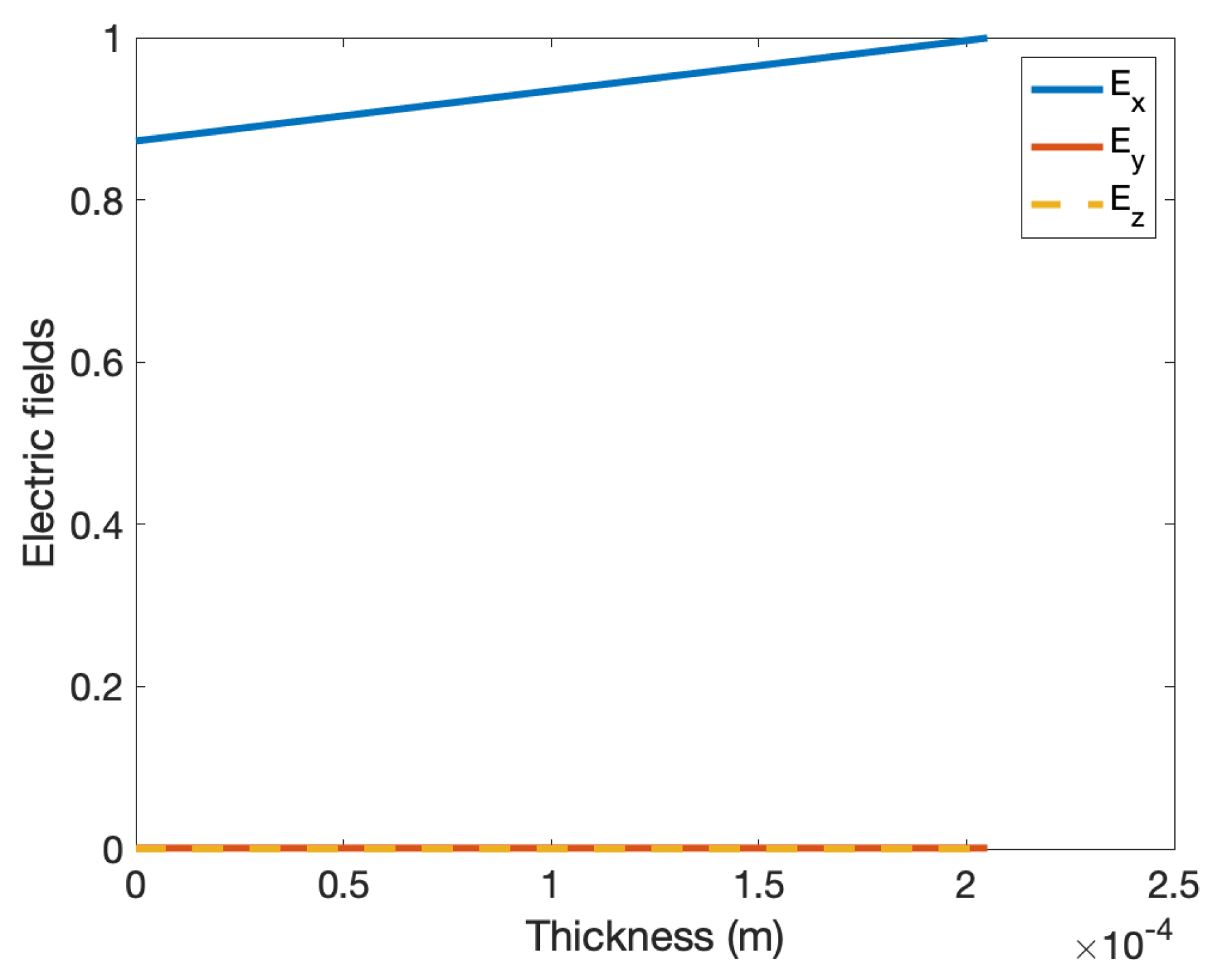
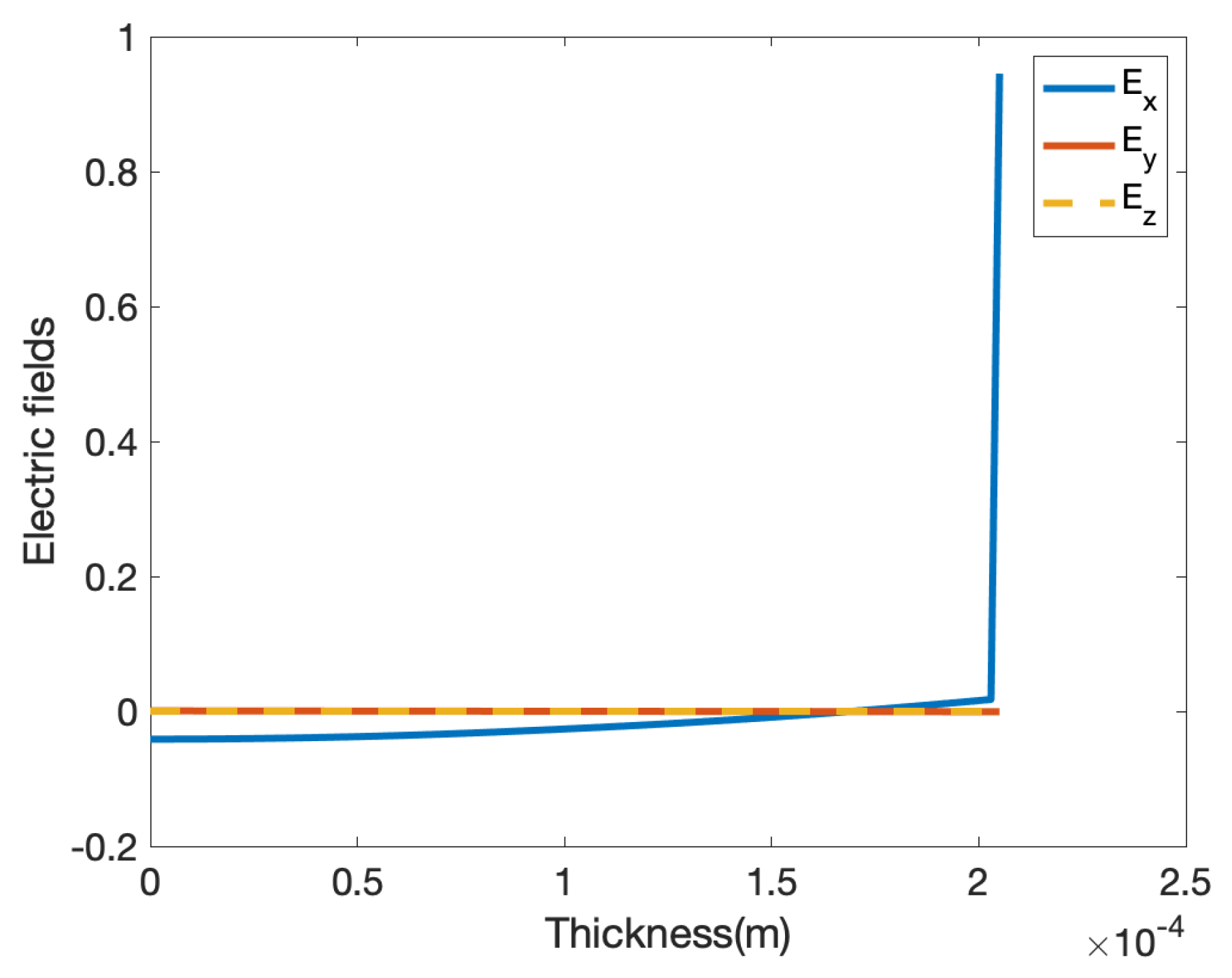
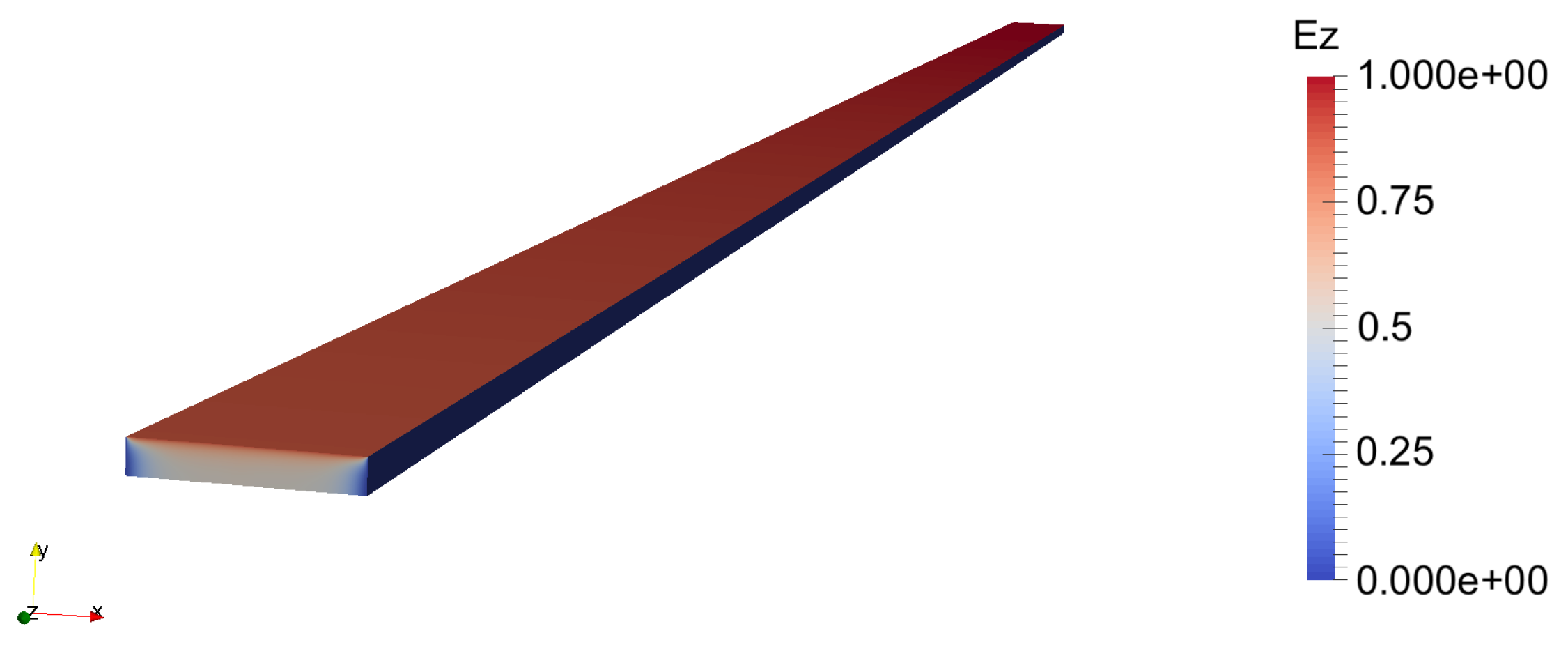
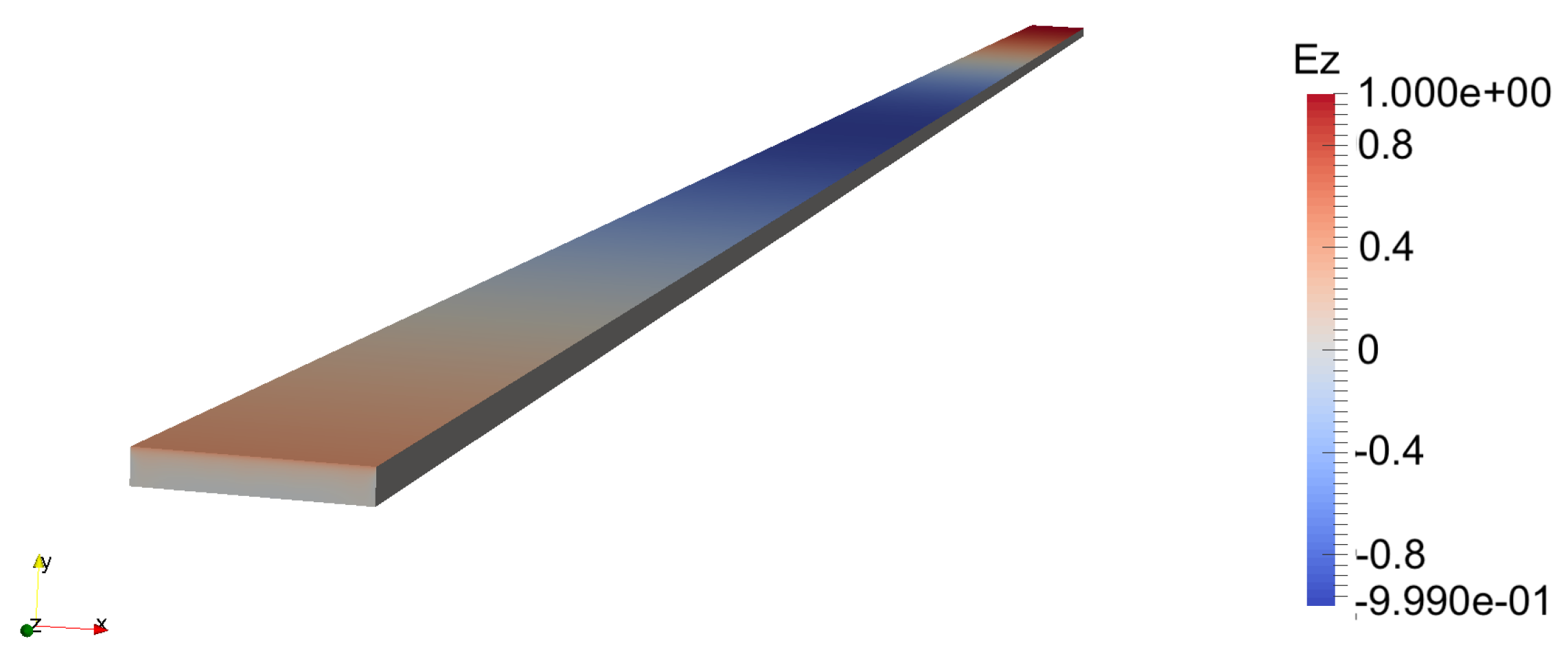
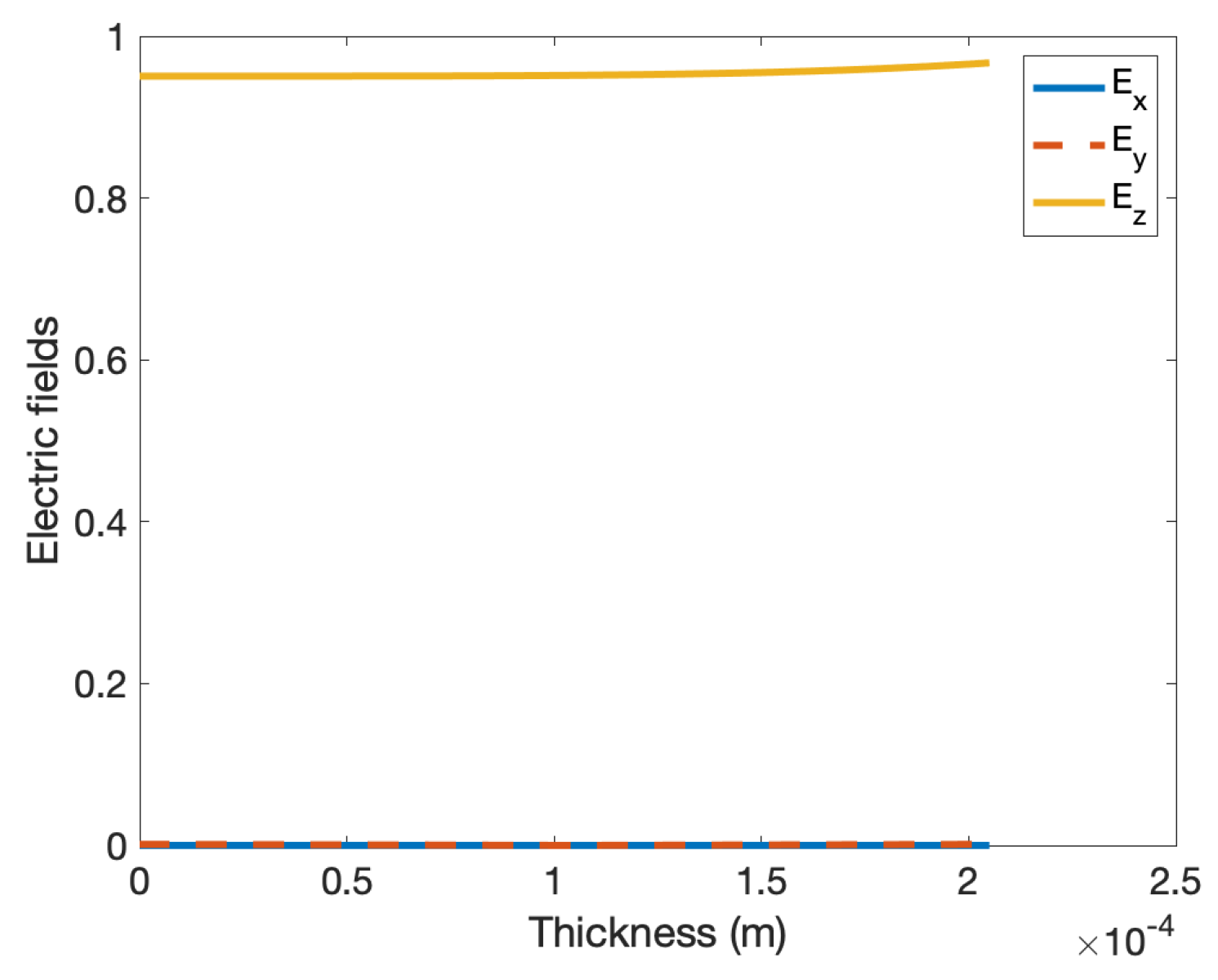
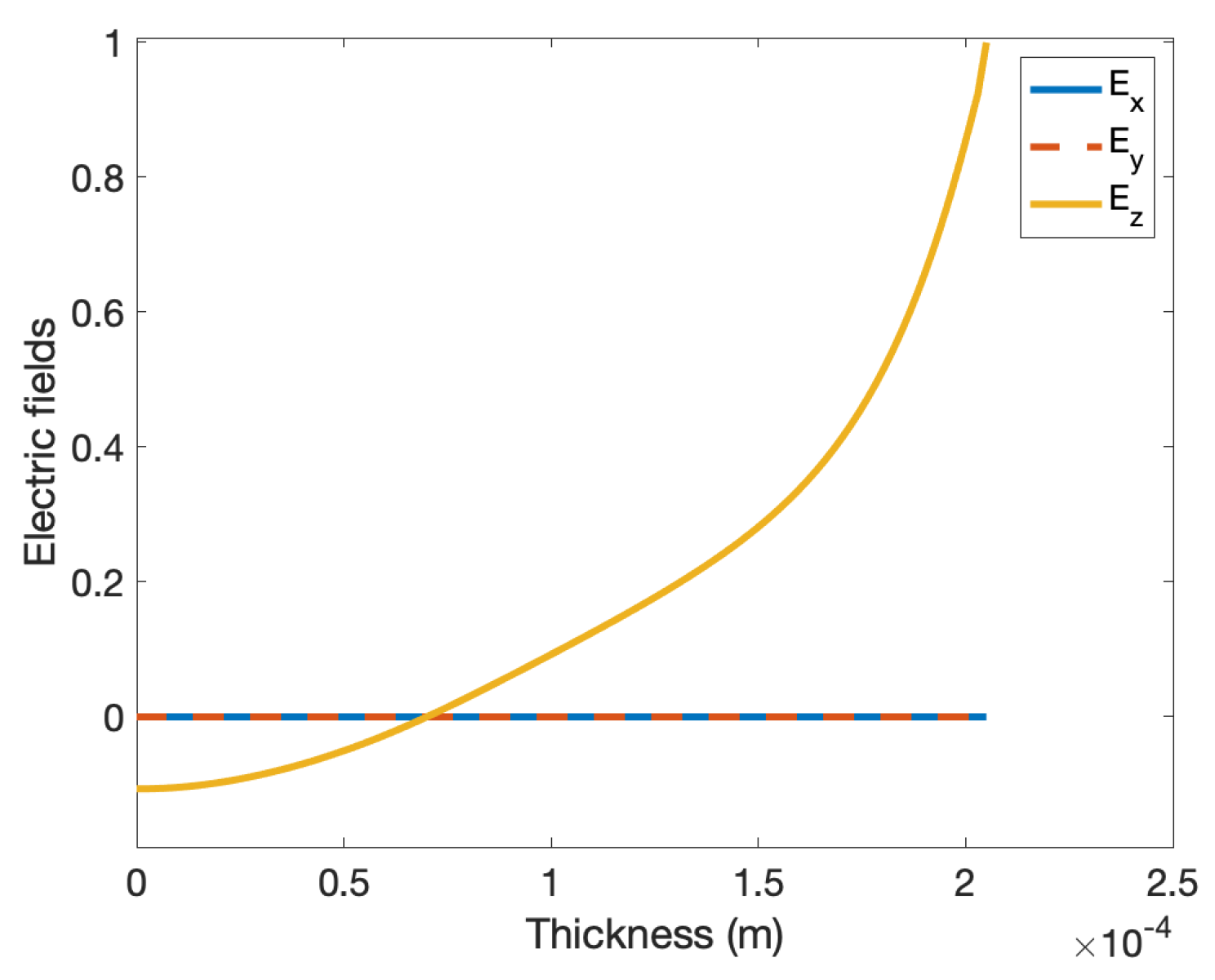
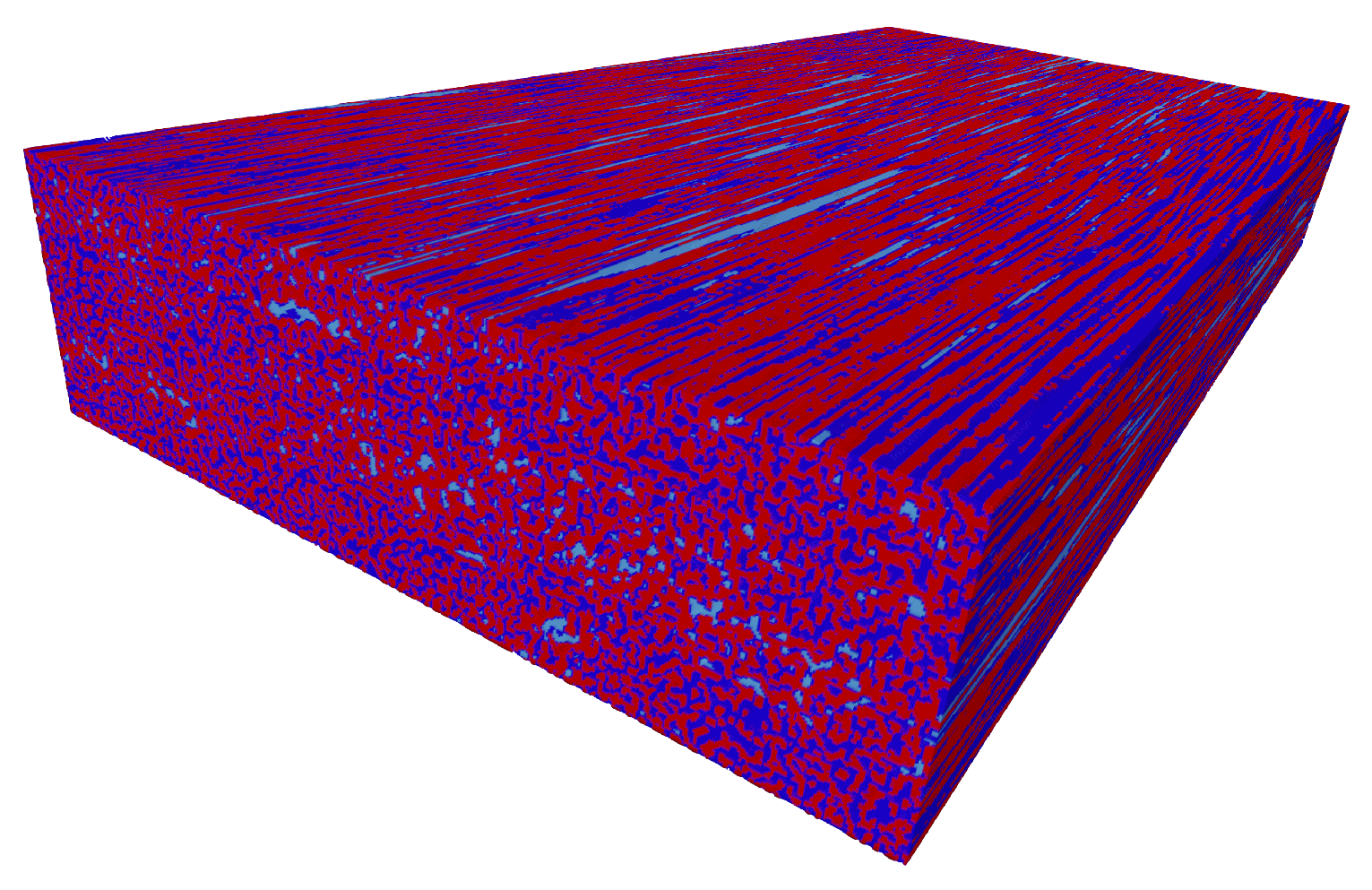
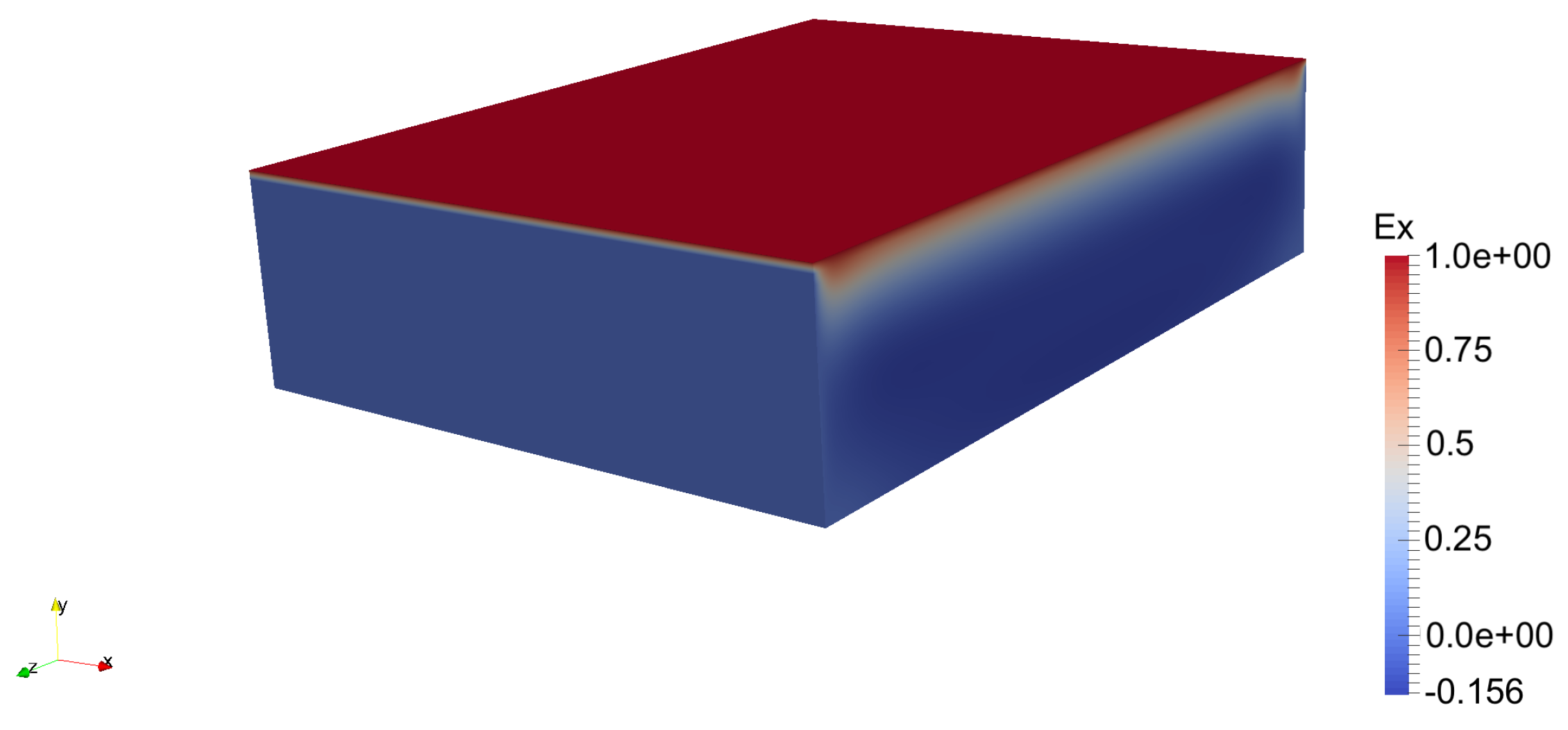
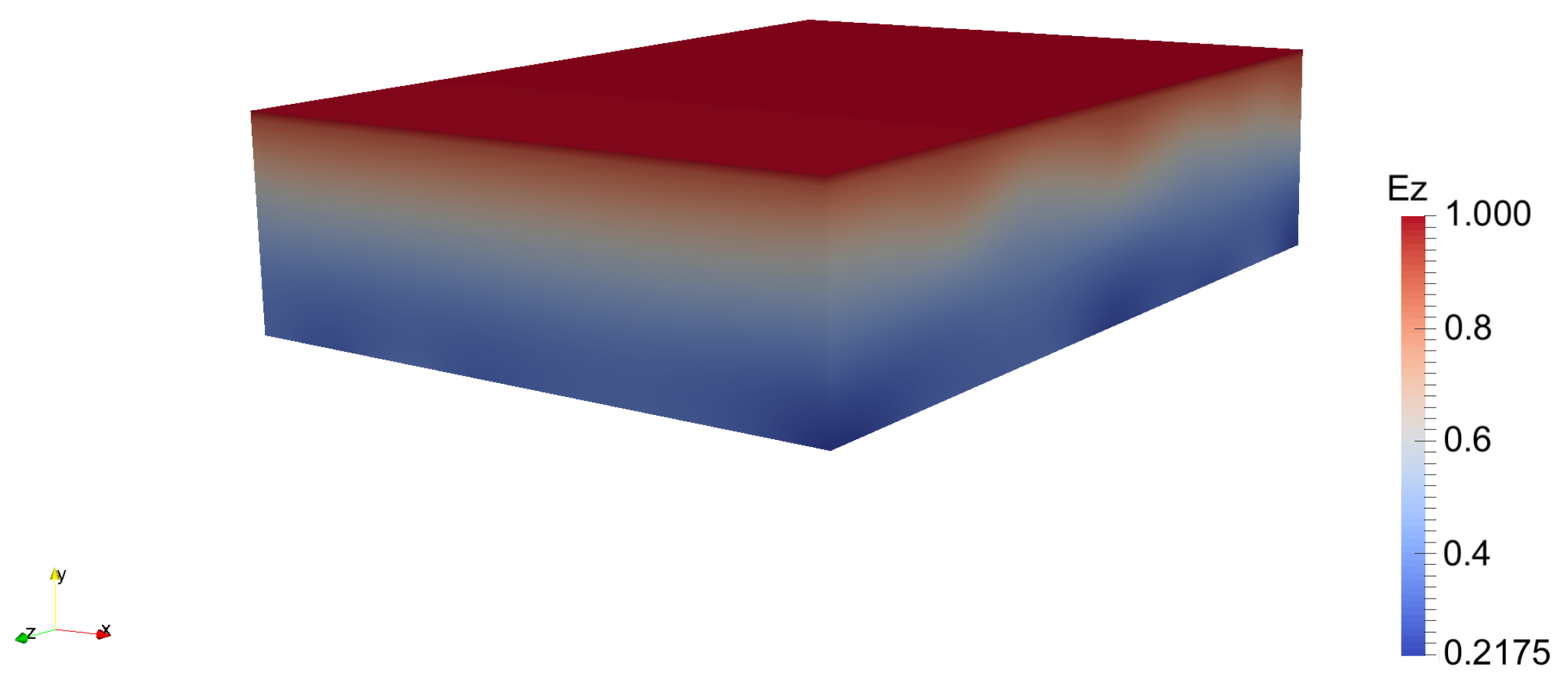
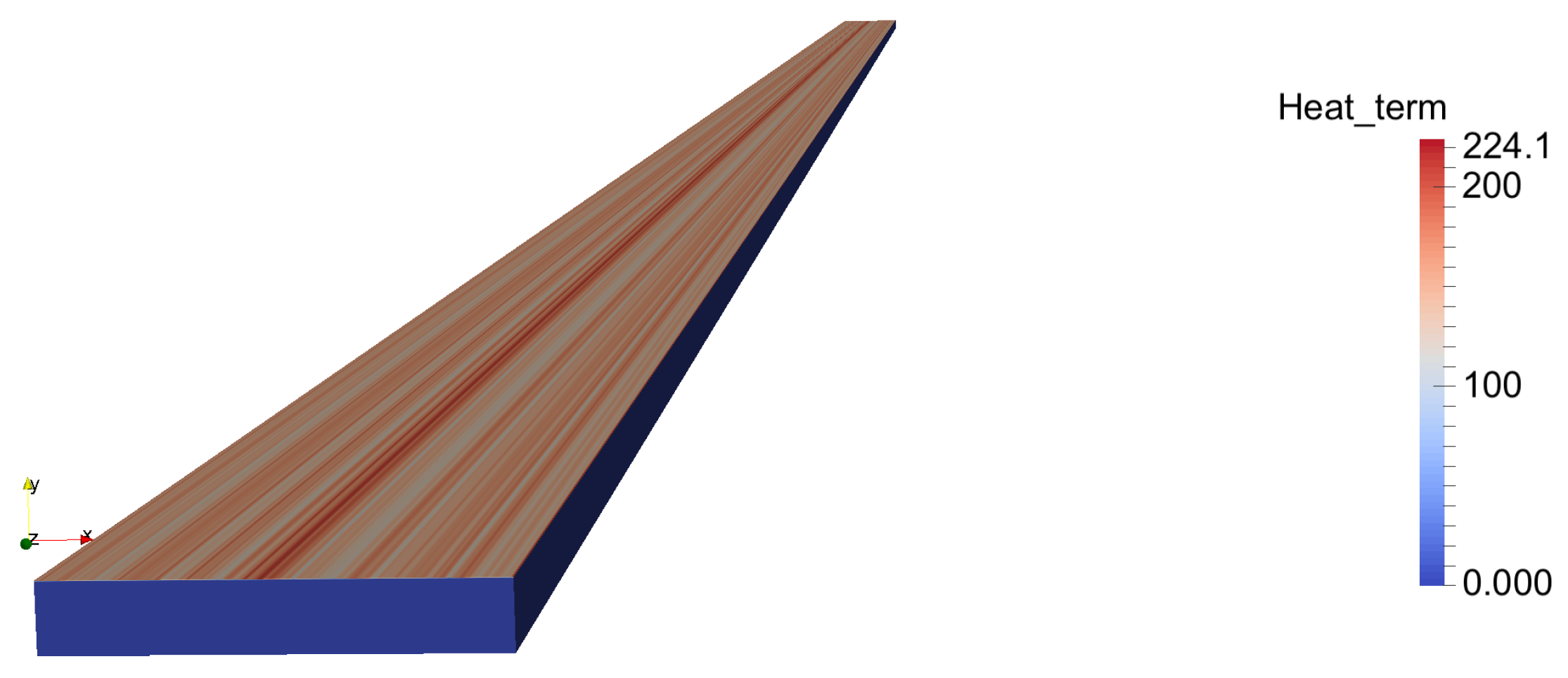
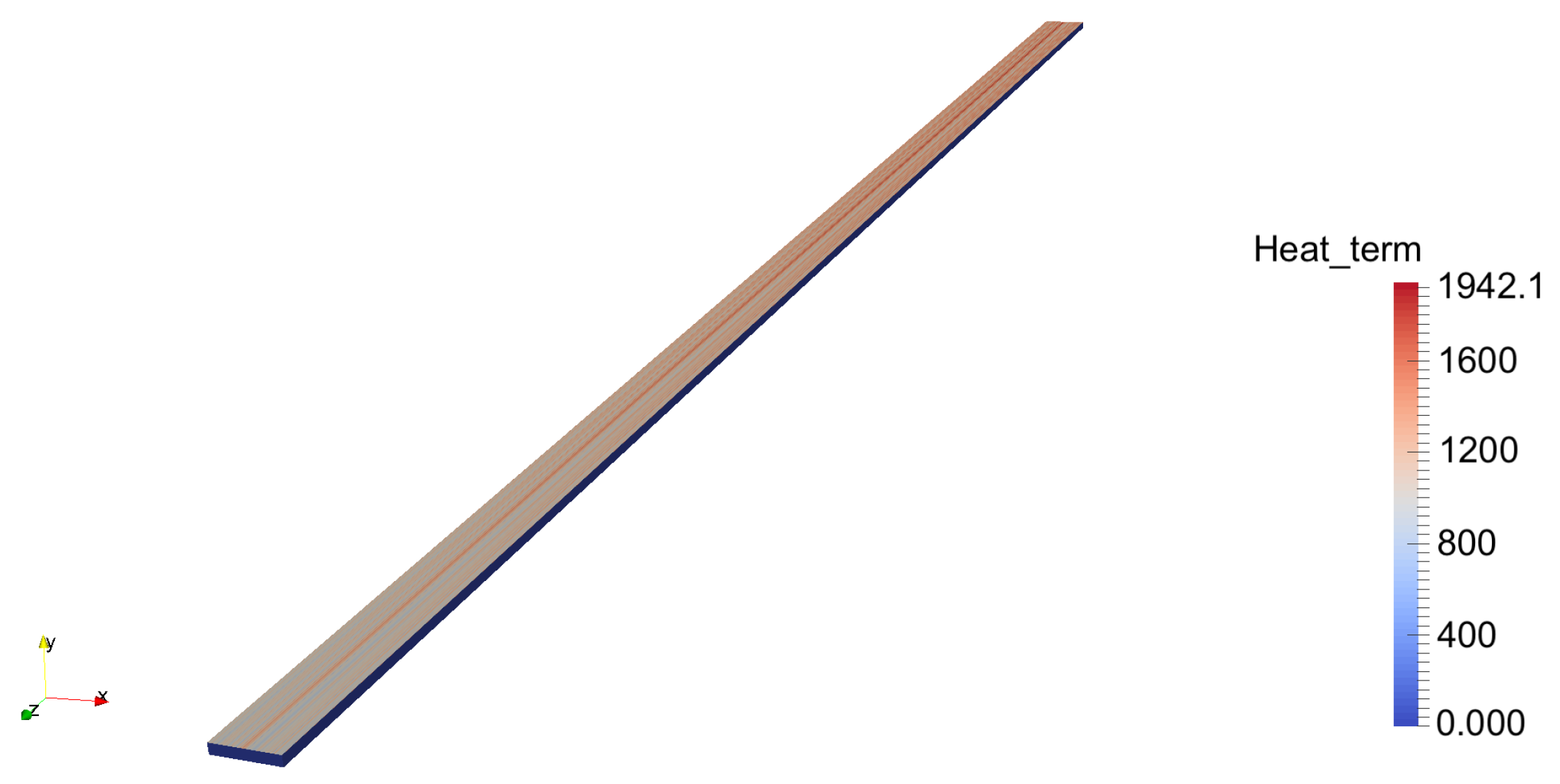
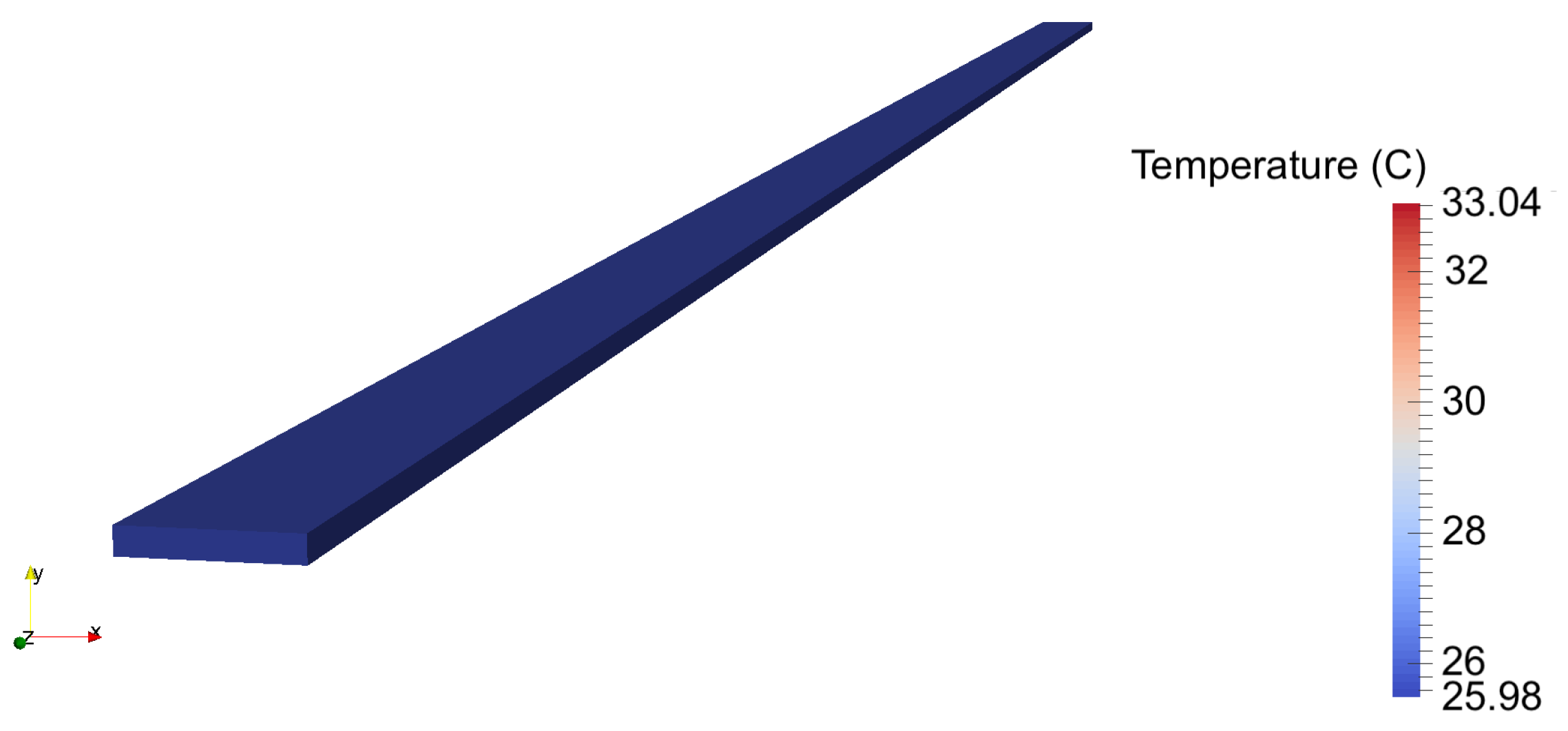
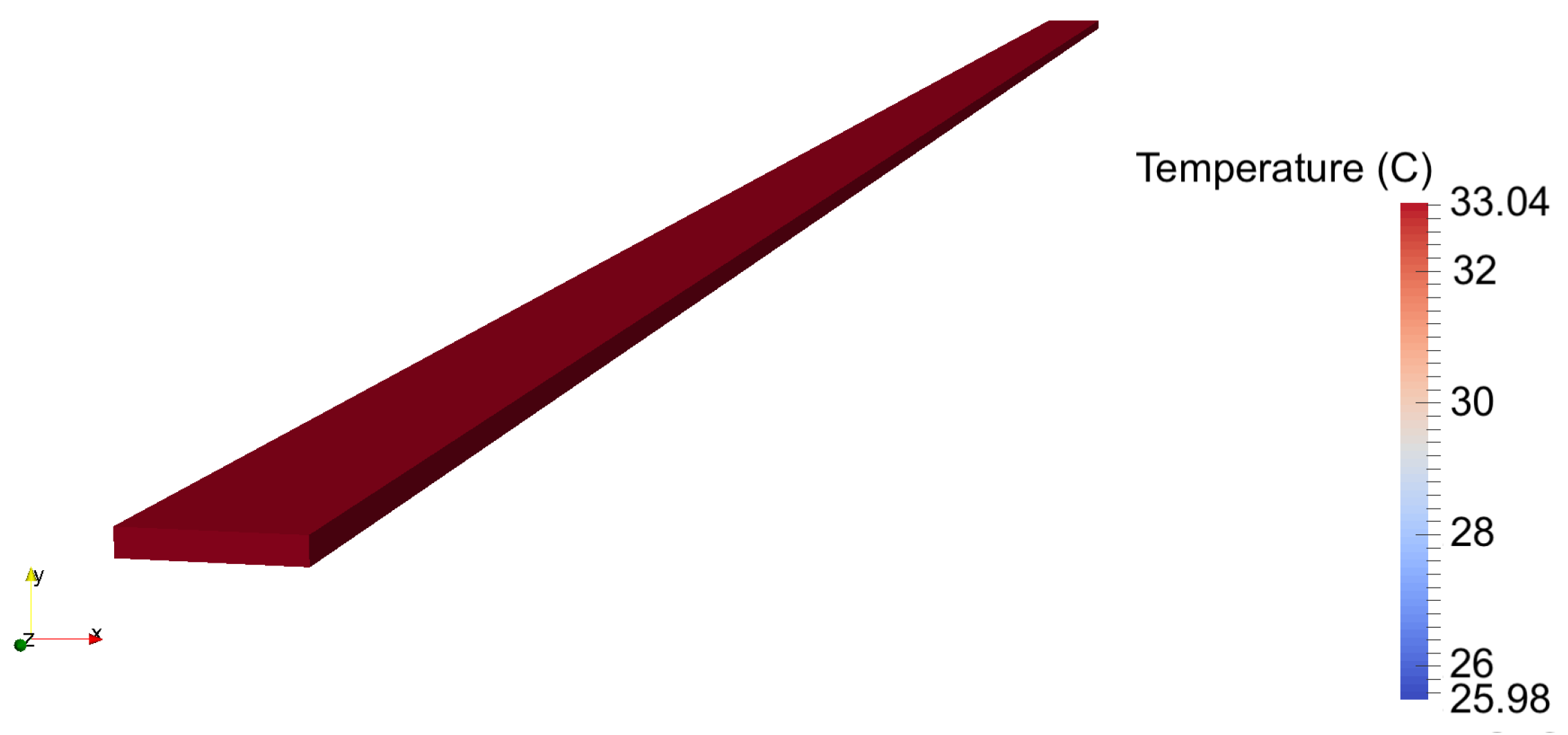
| Parameter | Value // to the Fibers | Value ⊥ to the Fibers | Value in the Matrix |
|---|---|---|---|
| 1 | |||
| 1 | 1 | 1 | |
Publisher’s Note: MDPI stays neutral with regard to jurisdictional claims in published maps and institutional affiliations. |
© 2022 by the authors. Licensee MDPI, Basel, Switzerland. This article is an open access article distributed under the terms and conditions of the Creative Commons Attribution (CC BY) license (https://creativecommons.org/licenses/by/4.0/).
Share and Cite
Ghnatios, C.; Barasinski, A.; Chinesta, F. On the High-Resolution Discretization of the Maxwell Equations in a Composite Tape and the Heating Effects Induced by the Dielectric Losses. Computation 2022, 10, 24. https://doi.org/10.3390/computation10020024
Ghnatios C, Barasinski A, Chinesta F. On the High-Resolution Discretization of the Maxwell Equations in a Composite Tape and the Heating Effects Induced by the Dielectric Losses. Computation. 2022; 10(2):24. https://doi.org/10.3390/computation10020024
Chicago/Turabian StyleGhnatios, Chady, Anais Barasinski, and Francisco Chinesta. 2022. "On the High-Resolution Discretization of the Maxwell Equations in a Composite Tape and the Heating Effects Induced by the Dielectric Losses" Computation 10, no. 2: 24. https://doi.org/10.3390/computation10020024
APA StyleGhnatios, C., Barasinski, A., & Chinesta, F. (2022). On the High-Resolution Discretization of the Maxwell Equations in a Composite Tape and the Heating Effects Induced by the Dielectric Losses. Computation, 10(2), 24. https://doi.org/10.3390/computation10020024








